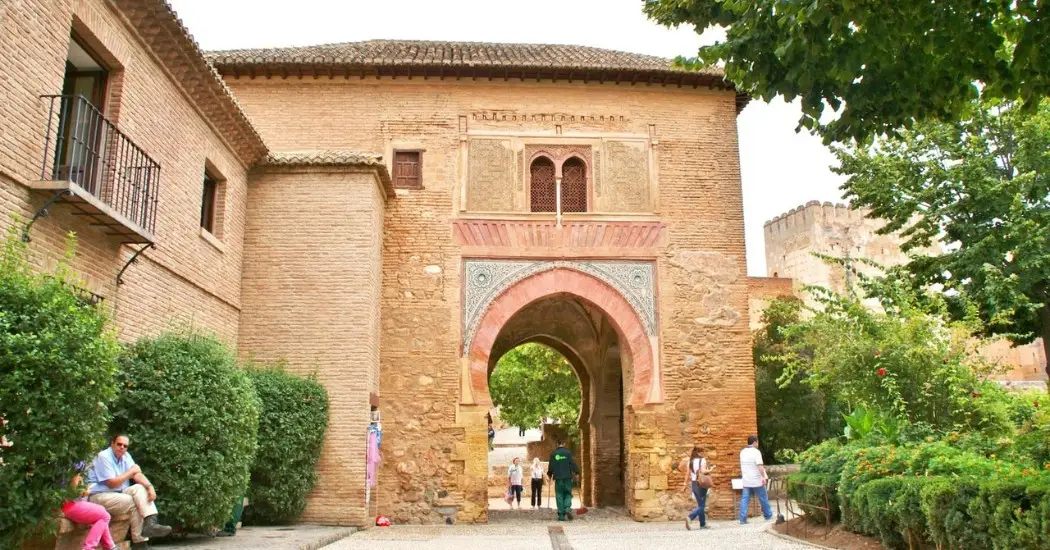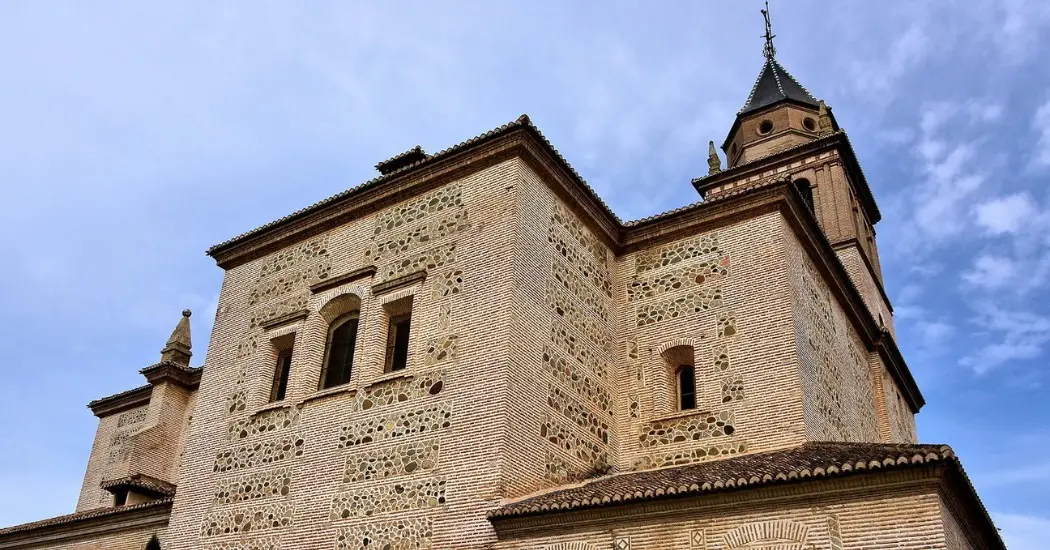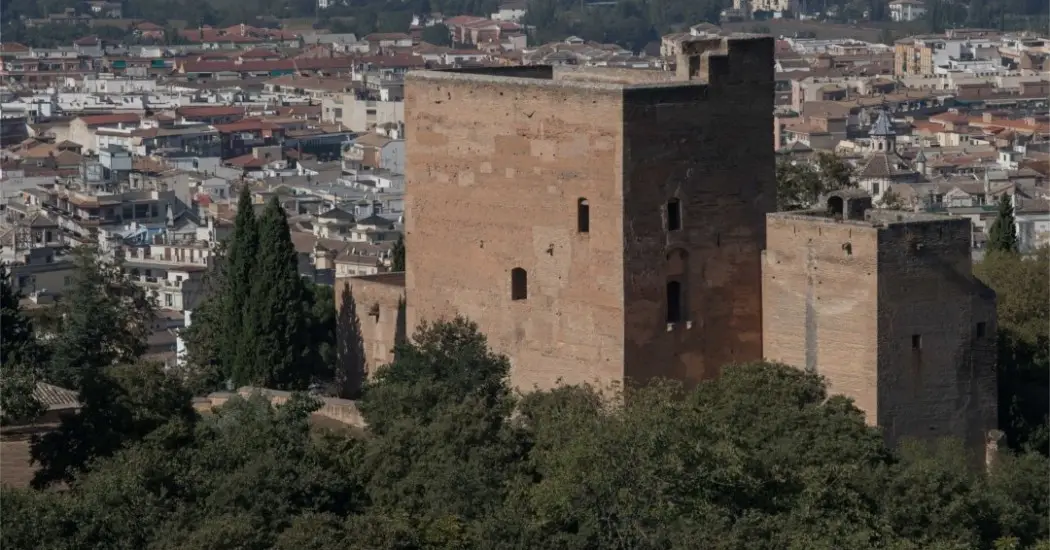Free Areas inside Alhambra
Places you can visit without a ticket

While the Nasrid Palaces, Alcazaba, and Generalife Gardens of the Alhambra castle require an entry ticket, there are several places inside the castle that you can visit for free.
These free attractions inside are especially useful if you don’t have an Alhambra ticket, which is why they are perfect for last-minute planners, budget travelers, and curious wanderers.
In this guide, we’ll walk you through all the beautiful attractions inside and around the Alhambra Palace that you can visit for free without a ticket.
The Alhambra Castle attracts over 2.6 million visitors annually, so booking in advance is a smart choice. The skip-the-line ticket is the most popular and budget-friendly option. For a deeper understanding of the palace, the guided tour offers expert insights, while the night tour provides a magical experience in a peaceful atmosphere.
The Gate of Pomegranates (Puerta de las Granadas)

If you decide to walk from the city to the Alhambra palace (approx 20 minutes), the first attraction you see is the Gate of Pomegranates.
The gate was built in 1536, replacing an older entrance called Bib-Albuxar. It features carvings of pomegranates, the symbolic fruit of Granada, and consists of three arches, one in the center for horses and two on the sides for pedestrians.
This gate serves as the main entrance to the Alhambra forest
Walk from Plaza Nueva to Cuesta Gomérez road, and you will come across the Gate of the Pomegranates. Get Directions
Alhambra Forest
As you pass through the Pomegranate Gate, you will enter the Alhambra forest, which surrounds the castle.
The Alhambra forest was planted in the 17th century and covers the historic Sabika Hill on which the Alhambra stood.
From here, three paths will lead into the Alhambra Palace, the side ones reserved for pedestrians only. Get Directions
Fountain of Charles V
If you take the pedestrian path on your left, you’ll find this stunning Renaissance Fountain of Charles V. Get directions
The Fountain of Charles V features three water spouts, each representing rivers of Granada: Beyro, Darro, and Genil.
Gate of Justice

Pass the Fountain of Charles V, climb the stairs, and turn to the left, and you will reach the Gate of Justice, one of the main entrances to the old walled city of the Alhambra Palace. Get directions
The Gate of Justice was built in 1348 during the rule of Yusuf I and features two arches.
You’ll notice a carved stone hand on the outer arch known as the Hand of Fatima (Khamsah). Its five fingers symbolize the core pillars of Islam: belief in one God, prayer, charity, fasting, and the pilgrimage to Mecca.
At the center of the inner arch, there’s a carved key, believed to represent the authority God gave to Prophet Mohammed to open and close the gates of Heaven.
Plaza de Los Aljibes
Enter through the Gate of Justice, and you’ll reach Plaza de Los Aljibes. Get directions
Plaza de Los Aljibes is a large open square between the military area and the palaces of Alhambra.
The square includes two long halls topped with barrel-vaulted ceilings, and another water reservoir is located at its northern end.
When the Palace of Charles V was built, the area was enlarged, and part of the southern wall had to be removed.
From this area, you can enter the Alcazaba and Torre de la Vela.
The Gate of Wine

Take the right from Plaza de Los Aljibes, you’ll see the Gate of Wine, which served as the principal entrance to the medina. Get directions
The Gate of Wine is among the oldest structures in the Alhambra, built during the reign of Muhammad III between 1302 and 1309.
Unlike the outer gates, this one is not built in a L-shaped pattern and leads directly to the old artisans’ district.
Palace of Charles V
When you cross the Gate of Wine, you will find the Palace of Charles V. Get directions
There are two museums at the Palace of Charles V: The amazing Museum of the Alhambra and the Museum of Fine Arts (free only for EU citizens).
Church of Santa María de la Encarnación

Follow the street called the Calle Real (Royal Street) on the right side of the Palace of Charles V, and you can see the Church of Santa María de La Encarnación. Get directions
Santa María de la Encarnación is a 17th-century Church that replaced the Great Alhambra Mosque and was built here to symbolize the triumph of Christianity over Islam.
The statue of Saint Mary of the Alhambra, created by Torcuato Ruiz del Peral between 1750 and 1760, is honored here. Every Easter, it is carried to Granada in a well-known and much-loved procession.
Saint Francis Convent, now the Parador Hotel
If you continue walking on Calle Real road, you will reach the old Saint Francis Convent, turned into a luxury hotel today. Get directions
The Saint Francis Convent is the place where the Palace of Muhammad III (1303-1309) once stood, but the Catholic Monarchs later donated it to the Franciscan order to establish the city’s first convent, which was completed in 1495.
Queen Isabella was temporarily buried here until the Royal Chapel, her final resting place, was completed.
The chapel and viewpoint are worth checking out, especially for their royal history.
Angel Barrios Museum

While returning towards the Palace of Charles V, you can see the Angel Barrios Museum. Get directions
Angel Barrios was a famous musician and composer from Granada.
The museum is located where the Bath of the Great Mosque of the Alhambra once stood. You can see its remains and a Nasrid house.
Gate of the Carriages

Continue walking towards the Palace of Charles V, and turn left towards the forest to get to the Gate of the Carriages. Get directions
The Gate of the Carriages was opened between 1526 and 1536 with the sole purpose of facilitating passage for the construction works in the Palace of Charles V.
Cuesta de Gomérez
Once you have explored the Gate of Carriages, you will be back on the same street as before: Cuesta de Gomérez. Get directions
Here you’ll see the monument to Ángel Ganivet, a writer and diplomat from Granada, and an important figure in the Generation of 98.
Bib-Rambla Gate

Walk a bit further from the Ángel Ganivet to reach the historic Gate of Bib-Rambla. Get directions
Bib-Rambla Gate served as the entrance to the square once known as Bib-Rambla, up until the late 19th century.
Despite its status as a National Monument, the gate was dismantled in 1894 and moved, first to the Archaeological Museum, and later to its current location in 1933.
It was also called the Arch of the Ears and Hands because the severed ears and hands of criminals were displayed here as punishment.
Carmen de los Mártires
Turn left from the Cuesta de Gomérez road to reach the Manuel de Falla Auditorium and Carmen de los Mártires gardens. Get directions
During the Nasrid period, Carmen de los Martires served as a prison, but the Catholic Monarchs later transformed it into a convent.
Right next to Carmen de los Mártires, the Alhambra Palace Hotel offers a terrace with stunning sunset views over the Realejo quarter.
Torres Bermejas

Facing the Alhambra Palace Hotel, take the main street on your right, called Callejón Niño del Royo, to pass the Rodríguez Acosta Foundation and reach the Torres Bermejas. Get directions
Torres Bermejas (Crismon Towers) watchtowers, constructed in the 11th century over older fortifications, were built to strengthen the defensive walls.
These towers stood at a key vantage point overlooking the Vega of Granada and were linked to the Alcazaba by a connecting wall.
